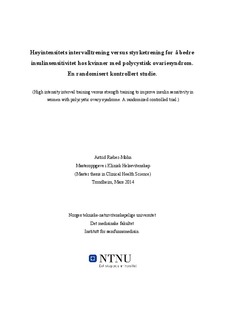| dc.description.abstract | Background: Polycystic ovary syndrome (PCOS) is a common endocrine disorder affecting
re-productive aged women. PCOS is associated with metabolic complications and an adverse
cardiovascular disease (CVD) profile. Impaired insulin sensitivity is an important factor in the
complex pathophysiology of PCOS. The prevalence of IR is higher in PCOS woman
compared with weight-matched controls. Previous studies have shown a beneficial effect on
IR after aerobic exercise with moderate intensity in women with PCOS. However, limited
knowledge exists on the effect of high intensity interval training and strength training in this
population.
Objectives: The primary aim of the present study was to assess the possible effect of high
intensity interval training (HIT) or strength training (ST) on insulin sensitivity among women
with PCOS compared with a control group (CG). Fasting glucose and insulin c-peptide were
measured as secondary outcomes.
Methods: Thirty-one previously sedentary PCOS women were randomized to one of the
following groups: high intensity interval training (HIT; n=10), strength training (ST; n=11) or
control group (KG; n=10). The intervention period was ten weeks with exercise three times
per week for HIT and ST. Insulin sensitivity calculated as «Homeostasis Model of
Assessment - Insulin Resistance» (HOMA-IR), fasting plasma glucose and insulin c-peptide
were evaluated and compared between groups. The mean changes in each group was reported
as estimated marginal means (EMM), as assessed by 95 % confidence interval (CI) and
considered significant if the 95 % CI did not include zero. Covariance analyses, with
Bonferroni adjustment, were used to test difference between groups, with the difference as the
dependent factor, group variable as the fixed factor, and baseline values as covariates.
Results: Insulin sensitivity (HOMA-IR) was significantly improved by 21 % after HIT
[EMM: -0.30, 95 % CI: -0.45 to -0.15] and by 17 % after ST [EMM: -0.23, 95 % CI: -0.43 to
-0.02], and not in the CG. Fasting insulin c-peptide was reduced after HIT [EMM: - 0.11
nmol/l, 95 % CI: -0.19 to -0.04] and after ST [EMM: -0.11 nmol/l, 95 % CI: -0.20 to -0.02],
and not in the CG. There were no significant changes in plasma glucose level in neither
group. We found no between-group difference in the change in insulin sensitivity (p=0.41) or
insulin c-peptide (p=0.61).
Conclusion: These data indicate that ten weeks of regular HIT and ST have beneficial effect
on insulin sensitivity in women with PCOS. | nb_NO |
